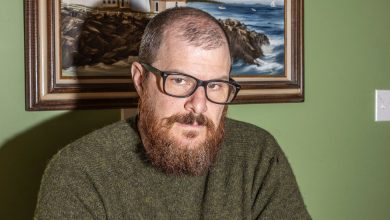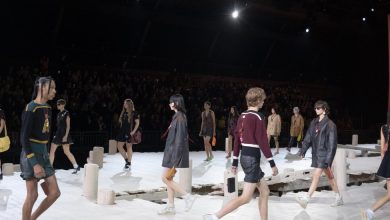Grace Mirabella, Who Brought Vogue Down to Earth, Dies at 92

Grace Mirabella, who as editor in chief transformed Vogue magazine from a glittery, color-splashed paean to the spirit of the 1960s into a more sensible adviser to women entering the work force in the 1970s and ’80s, died on Thursday at her home in Manhattan. She was 92.
The death was confirmed by her stepson Anthony Cahan.
Ms. Mirabella went on to found Mirabella, a magazine for women as interested in culture and travel as in clothes and interior design. But she made her biggest impact at Vogue. Her years there, from 1971 to 1988, coincided with women’s increasing financial independence. Many women were among the first in their families to work outside the home and were looking for guidance on a range of issues, starting with what to wear to their new jobs. Go-go boots and love beads would not do; they needed more practical clothes that fit their new lifestyles.
At the same time, as these women participated in the broader world, their interests widened, too. But Vogue, under its flamboyant editor Diana Vreeland, had entered the ’70s still stuck in the ’60s. The magazine’s circulation was falling, and advertising along with it.
Even so, Ms. Vreeland’s firing by Vogue’s publisher, Condé Nast, in 1971 came without warning. The move was so abrupt that Ms. Mirabella, Ms. Vreeland’s second in command, was notified of her promotion while on a photo shoot in California.
Where Ms. Vreeland was colorful, electric and theatrical, Ms. Mirabella was pragmatic and businesslike. Her mandate was to change the character of the magazine, and Vogue quickly took on the values of its new editor, becoming more accessible and down to earth.
To signal the new mood, Ms. Mirabella had the red walls of the editor’s office repainted beige, and she often wore tailored beige clothes to work.
“I’m not a clothes girl if it means talking about them all the time,” she said in an interview shortly after her appointment. “But I think they’re interesting, and I have quite a lot of them.”
Ms. Mirabella’s Vogue emphasized the natural in hairstyles, makeup and clothing over artifice — the spare designs of Ralph Lauren, Calvin Klein and Giorgio Armani over fashion as fantasy or work of art.
The magazine added sections on the arts, fitness, health and beauty while keeping its emphasis on fashion. Circulation tripled during Ms. Mirabella’s tenure, to more than 1.2 million in 1988 from 400,000 in 1971.
But while she was considered the most powerful woman in fashion, she kept the focus on fashion and not herself, said Samir Husni, a professor of journalism and director of the Magazine Innovation Center at the University of Mississippi School of Journalism. “She was an icon, a legacy,” Professor Husni said in an interview for this obituary.
She was also hard-working.
“Nobody,” he said, “ever wrote a book about her, ‘The Devil Wears Prada,’” a reference to the novel, later made into a movie, based on Ms. Mirabella’s successor at Vogue, Anna Wintour. “She wore the Prada without the devil.”
By the mid-1980s, though, the pendulum of fashion had swung again. There was new money and a new interest in the comings and goings of celebrities. Fashion was becoming more about trendiness, and Vogue was not reflecting these sensibilities.
Though it still dominated the world of fashion magazines, Vogue was facing new competition. One of its competitors, American Elle, had become a force almost overnight, with an emphasis on a youthful European approach.
Elle was introduced in September 1985; by the end of the next year, its paid circulation was 861,000. In June 1988,Ms. Mirabella was ousted — as abruptly as Ms. Vreeland had been before her — and replaced with Ms. Wintour, 20 years her junior. Ms. Wintour had been creative director at Vogue from 1983 to 1986 before becoming editor of British Vogue and then House & Garden (which was renamed HG in 1988).
In an interview after the move, S.I. Newhouse Jr., the chairman of Condé Nast, made no apologies, saying it was time to “reposition Vogue for the ’90s.”
“There have been clear lines of what was high fashion and casual fashion,” Mr. Newhouse said. “I think those lines are less apparent now. I think the change in the 1990s, when we look back, will be as decisive as the shift from the ’60s to the ’70s.”
A few months later, Ms. Mirabella announced that she would launch her own publication. Mirabella magazine, which was backed by Rupert Murdoch, was meant to be about “much more than clothes or interior design,” she wrote in the inaugural issue, dated May 1989. It was to be about style, she said, which “informs every aspect of our lives,” and it would offer serious articles along with fashion and beauty advice.
Ms. Mirabella never explicitly stated what age group her magazine was aimed at, but she did say that it was targeted at educated women concerned with politics, psychology and business.
She left the magazine in 1996 to lecture and do freelance writing. The magazine, which never turned a profit and often struggled to find a coherent voice, was shut down in 2000.
But Professor Husni said that the mere existence of the magazine reflected Ms. Mirabella’s stature in the industry. “I give a lot of credit to Rupert Murdoch,” he said. “When you’re on your way out, no one honors you. But that’s how important she was.”
Marie Grace Mirabella was born on June 10, 1929, in Newark, the daughter of Anthony Mirabella, a sales manager for a liquor importing company, and Florence (Belfatto) Mirabella, who had immigrated from Italy.
Shortly after graduating from Skidmore College in Saratoga Springs, N.Y., in 1950 with a bachelor’s degree in economics, she joined the executive training program at Macy’s. She then briefly worked at Saks Fifth Avenue before taking a job at Vogue in 1952 verifying store credits in photo captions.
She was on the public relations staff of the designers Simonetta & Fabiani in Rome from 1954 to 1955 before returning to Vogue in 1955 as the shopping editor, searching small shops for unusual fare. With a reputation for working hard, she climbed her way up through a succession of jobs at the magazine.
In November 1974 she married William G. Cahan, a thoracic surgeon who specialized in breast and lung cancer at Memorial Sloan Kettering Cancer Center in Manhattan. Dr. Cahan was an early leader in national efforts to combat smoking.
In addition to her stepson Anthony Cahan, she is survived by another stepson, Christopher Cahan; seven step-grandchildren; and three step-great-grandchildren.
In her book “In and Out of Vogue” (1995), written with Judith Warner, Ms. Mirabella settled some scores from her days at the magazine. She described Ms. Wintour as “a vision of skinniness in black sunglasses and Chanel suits” and claimed that the photographer Richard Avedon had “achieved some of his best results with girls who were utterly strung out on dope.”
As to the reasons she was pushed from her perch, she wrote that the 1980s were “an emperor-has-no-clothes era, start to finish.” Clothes, she said, “were about labels, designers were about being celebrities, and it was all, on a bigger and bigger scale, about money.”
Fashion had degenerated, she wrote, “into a self-reverential game full of jokes and pastiches that amused the fashion community enormously and did nothing at all for the woman shopping and trying to find something to wear.”
Alex Traub contributed reporting.




